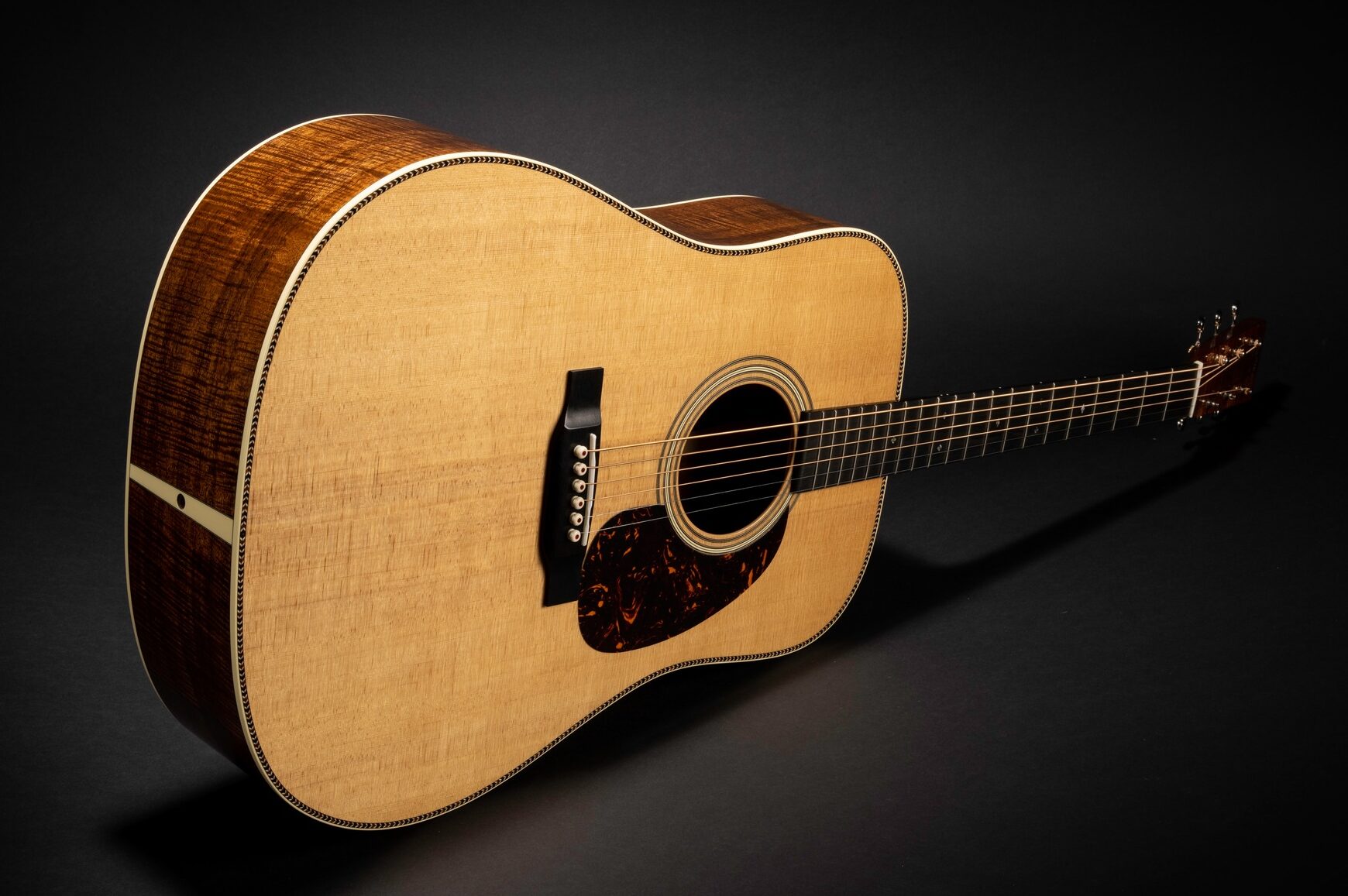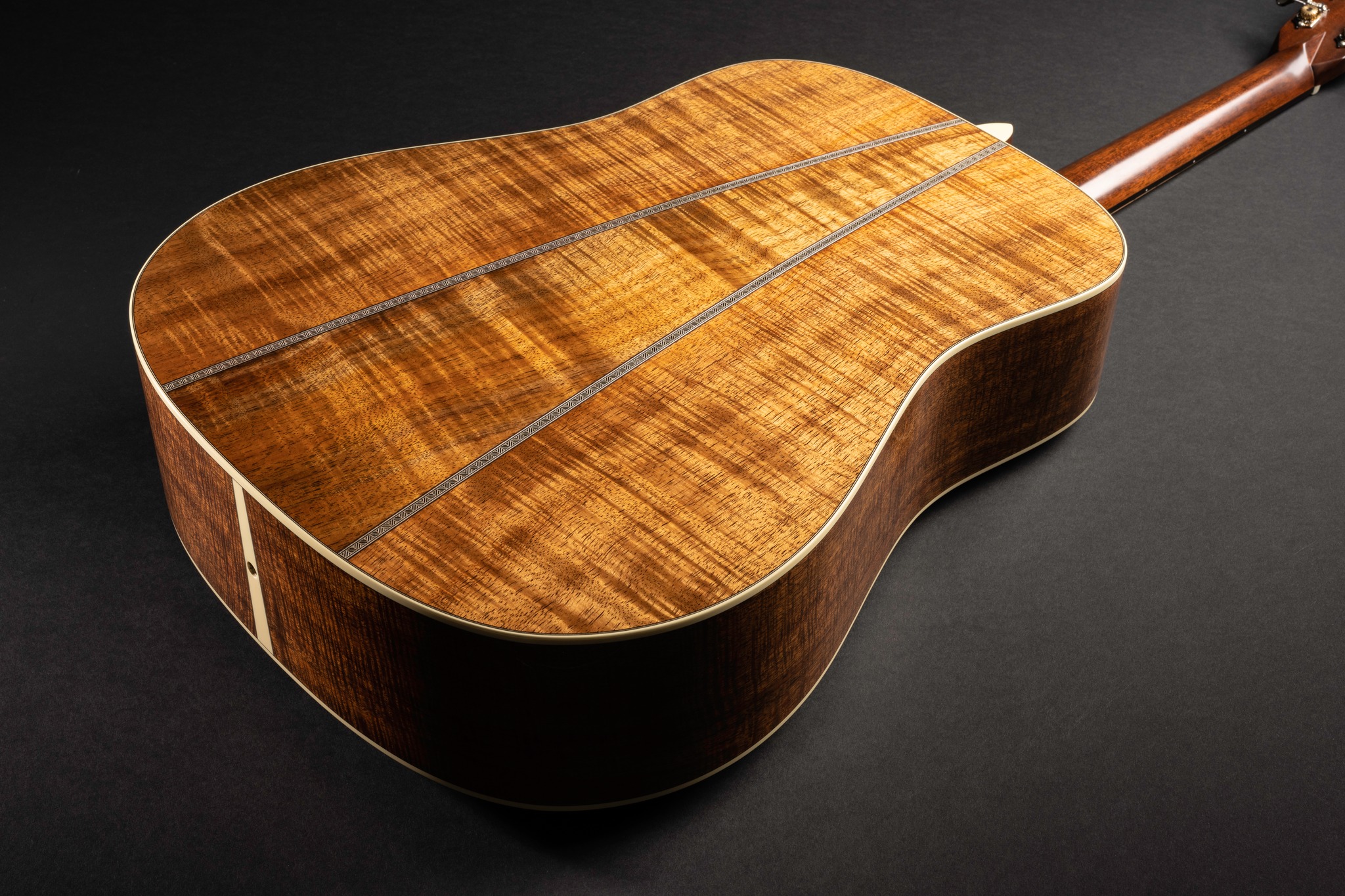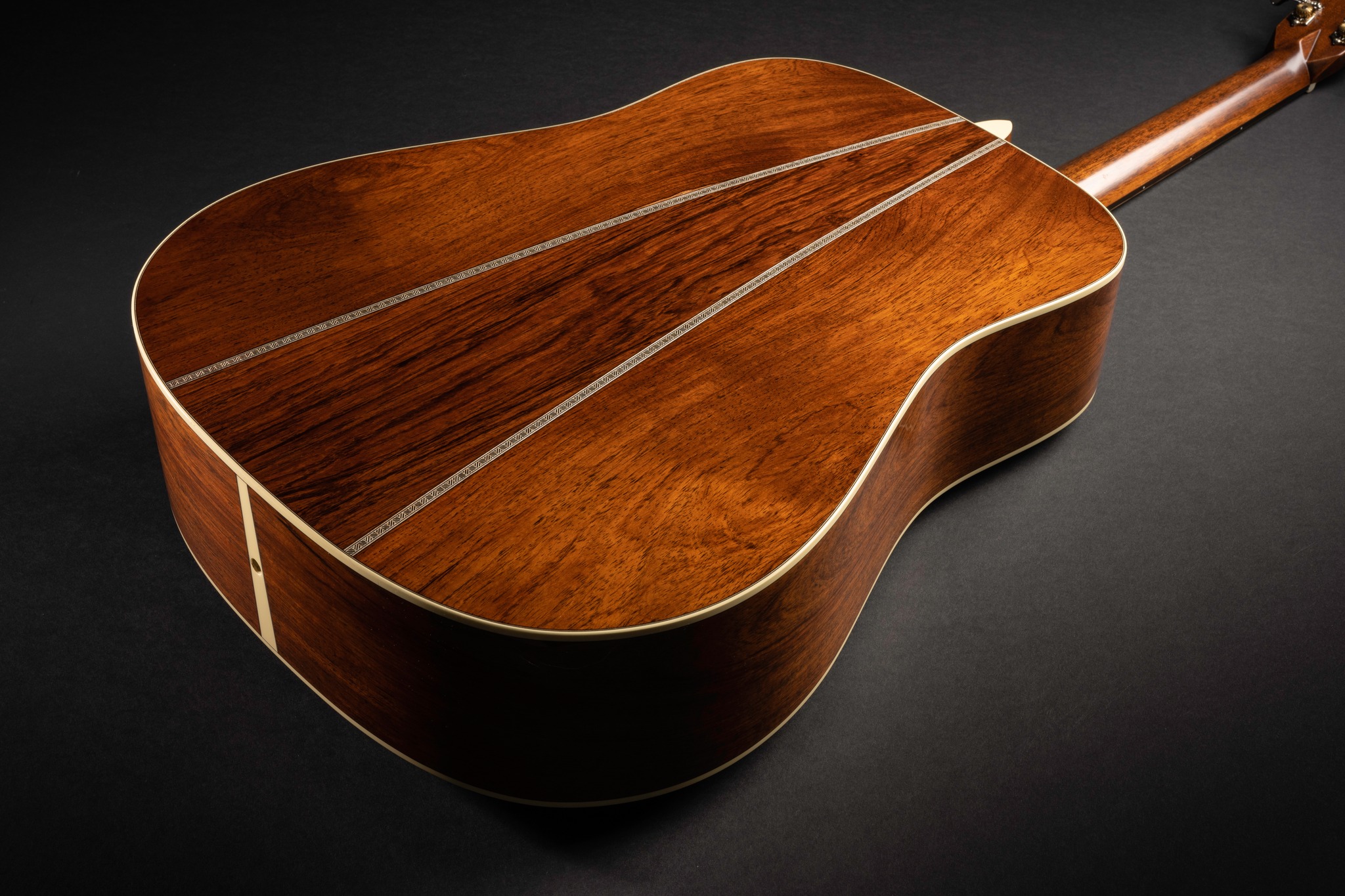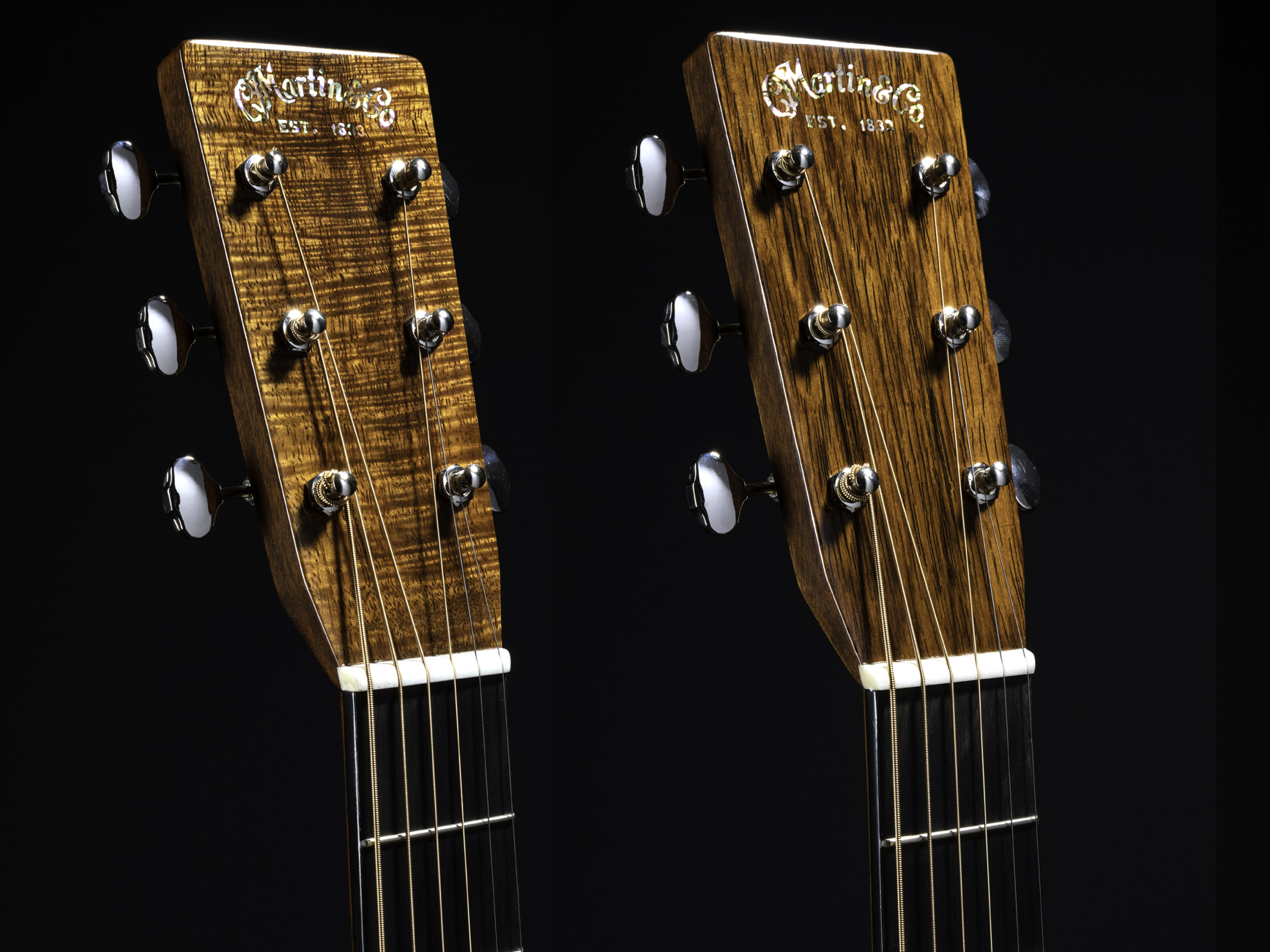C. F. Martin & Co. introduces the CS Super Dreadnought for Autumn 2022
The new Super D is Available at Custom Shop Expert Dealers in two varieties
CS SD specs include: New SD-14 Fret body size; all-solid tonewood construction, choose between high flame koa or Guatemalan rosewood back and sides, Vintage Tone System Sitka spruce top with tri-color wood fiber herringbone purfling; forward 5/6″ scalloped Sitka spruce bracing; Genuine mahogany neck with a traditional full dovetail neck joint, Modified Low Oval profile; ebony fingerboard with High Performance taper, 1-3/4″ width at nut, 2-1/8″ at the 12th fret, long pattern Diamonds & Squares fret position markers; ebony belly bridge with short saddle and 2-5/32″ string spacing; abalone script headstock logo; nickel Grover tuning machines; natural nitrocellulose high gloss body finish and satin neck finish.
~
“This new model looks like the standard dreads, but it has 20% greater cubic volume in its sound chamber. This gives the Super D a super-sized voice that can seem like it needs a set of wheels all its own, if not a gun carriage. It is that powerful.”
I was able to play the new Super D guitars, but it was a complete surprise, so I was not able to make an official One Man’s Guitar video review. But hopefully I shall someday soon.
Martin’s Trend Bucking Super D
The Martin CS SD is created in the Custom Shop with the new Super Dreadnought body size. At a time when American acoustic guitar manufacturing has jumped on the ever-smaller bandwagon of “travel guitars,” C. F. Martin & Co. has taken things in the opposite direction, by announcing the creation of this new colossus.
Currently available in High Flame Hawaiian koa or tropical Guatemalan rosewood, these first official Super Dreadnought models will be sold through the network of dealers known as Custom Shop Experts. Both varieties have the same cosmetic motif featuring a new wooden herringbone trim and a three-piece back.
2020 Was Not All Bad
In the dark days of the COVID shutdown, I was having a catch-up chat on the phone with Tim Teel, Martin’s Head of Instrument Design. Although the factory had closed its doors, Tim and Fred Greene, Martin’s Vice President of Product Management, had been lightening the mood through their favorite pastime, brainstorming about future guitar models.
Fred, who learned the business at multiple companies, wanted to look away from the micro-guitar trend inundating the market, and think big – very big. Tim, who started working at Martin in his teens alongside his grandfather, wanted something new and exciting, but very much homegrown from out of the fertile Martin legacy.
Nothing is more Martin than their Dreadnought design. It originated as a 12-fret behemoth with sloped shoulders where the neck meets the body, which they named for the 42-cannon battleships that ruled the waves in the First World War. In 1934, Martin came out with the 14-fret version that has a slightly smaller sound chamber and squarish shoulders. It quickly conquered the world.
This new model looks like standard dreads, but it it has 20% greater cubic volume in its sound chamber than the standard D size instruments. This gives the Super D a super-sized voice that can seem like it needs a set of wheels all its own, if not a gun carriage. It is that powerful.
The modern Martin Dreadnought, known overseas as a “Western” guitar due to its association with cowboys and Country Western music, has been imitated by luthiers around the globe and is by far the most popular guitar size in history. The Super Dreadnought expands that size and its history into a big, bold future.
Big Bold Beauty
For this latest and in some ways greatest dread, Teel ultimately combined aspects of the 12-fret Dreadnought design with the 14-fret Dreadnought design, while keeping the normal depth and 25.4” string scale length. While that might sound like a simple idea, it took a great deal of thought and experimentation to achieve the right combination of 12-fret Dread prowess with a bracing layout that would work with the versatile 14-fret design.
“Everything had to grow,” is how Teel put it to me in October 2020, when I was filled in on the completed prototypes. The wider 16-1/2” soundboard required longer bars and braces. He had to come up with a proprietary bracing pattern that provided the proper support-to-resonance ratio. Sound tests determined that the best sound hole size was 1/8” larger than standard Dreadnoughts, or 4.125” to be precise. The shape is similar to the D-45S Authentic 1936 (S for Special Order) but not identical. Compared to the D-12 body size, the sound chamber is little smaller.
But there is nothing small about the audible volume! When they say “super” this SD has a bass as big as South Dakota. Their measurable test results reveal an increase in bass response of over 11 dB greater than their traditional 14-fret dreadnought. (!)
Big Bold Tone
Being told that is one thing. Hearing for myself was quite a revelation, indeed.
In July 2022, I shook hands with Tim Teel in the lobby at the Martin Museum and was happy to hear there was something he wanted to show me. I had not been permitted beyond the visitors center since the pandemic started, and I thought his haste to rush through the factory floor to the Design office was related to the latest COVD protocol, or his busy schedule. But he just wanted to hand me a Super Dreadnought as soon as possible.
What a pleasant surprise! The last I heard about this project, the Spring 2022 launch had been scrubbed. Tim hoped we would see these in the summer of 2023. His collaboration with Scott Sasser and his Custom Shop elves had been such a success, it seems, that the Chairman, C. F. Martin IV, gave the thumbs up to release the Super Dreadnought super early, barely two months after the NAMM show. Once this was elevated to a Custom Shop model, the original concept of a mahogany SD-18 and Indian rosewood SD-28 evolved into the amazing new CS SD models we have today.
Super Tone
The Guatemalan rosewood mines an enriched version of the super-duper bottom end, for a voice that is warm and lush as a Guatemalan jungle. The koa version, in addition to being visually stunning, is enhanced by that extra-large sound chamber for a fuller bottom end than most koa guitars, while amplifying those glistening koa high harmonics and immediate midrange notes.
They explode with power and color during heavy strumming, but also share a bit of that 12-fret dread balance with a midrange buoyed between the lows and highs, compared to normal D-14 models. They are so successful and complimentary that I am surprised Martin didn’t offer them as a matched set in a double case, like a brace of dueling pistols. But I guess that would be hard to carry on the subway to a gig.
I had a wonderful time handing them back and forth and playing them together with my college pal Bill Peebles, whose first trip to Martin began with a bang, or should I say a boom. I do not remember which one Bill liked best. It would be a very tough choice for me; had I been allowed to drive one of these Super Ds off the lot. Both are beautiful to the eye and ear.
Super Beautiful
The cosmetic appointments were in place by that October 2020 phone call and haven’t changed much at all. The decision was made to use a three-piece back. This would allow for more primo wood options not wide enough to use on a two-piece back. When it comes to koa, the production prototype I played had highly flamed wood with all sorts of 3D holographic illusions that can’t be captured in photos. It appeared like ribs and ridges of rippling sand or melting honey, overtop liquified amber. Glorious stuff!
The Guatemalan rosewood had a woven fabric sort of look, like what Madagascar rosewood often sports. In other words, of the same sort of quality used on the new D-28 Authentic 1937. Again, the deep sonic cellar of Guatemalan rosewood, similar to Brazilian in this respect, seems the perfect choice for the deep physical cellar of the Super D.
To accommodate the three back panels, the Custom Shop Super D has the duel Zig-zag back strips of the HD-35. But from the front, it looks more like an HD-28, with an unbound neck, while having a colorful abalone headstock logo, and the tri-color herringbone purfling around the edge of the VTS Sitka top. The purfling is made from ebony and maple.
The bracing under the top is also like the HD-28, consisting of a 5/16” scalloped X-brace and tone bars. I am not yet sure what I can share about the new bracing pattern. Not officially forward-shifted or standard-shifted or rear-shifted, “it is where it is.” Sayeth Tim Teel. When one puts their finger inside, there is a familiar forward position feel to it. It definitely has more of a forward-shifted rumble and roar than not.
The VTS Sitka spruce top had a lot to do with the Super Ds sounding so huge right off the Custom Shop workbench. Torrefaction is the process were materials, in this case wood, are placed in a low oxygen environment and heated past the tremendous temperatures that would otherwise incinerate it. It is said the Vikings invented it. It was later discovered that torrefied wood could make for amazing violin soundboards. In modern times, we know that the cellular interiors become crystalized until they are microscopically identical to wood that has naturally dried out over decades. Today’s Martin VTS tops tend to come in about 85 years old. This also toasts some of the resins in the wood, which results in the buff and tawny shading that turns every VTS top into a unique work of woody art. The light buff color of the Antique White binding has its own woody quality that works seamlessly with the new herringbone and the toasted top from Vintage Tone System kilns.
The CS Super D, in either variety, is likely just the first Super Dreadnought. We may yet see the size in the Standard Series at some future NAMM Show. I found it effortless to fingerpick because the bracing works so well with the wide soundboard that little effort is needed to make a lot of tone. But it is extremely fun to play full out and take everything to 11, just like those bass dBs heard only from the Super Ds. But beware if ye be timid in your music making. Just look what happened to poor Tenacious D, after just one night playing their new Martin CS Super Ds!
“If it’s good enough for Tenacious D, the SD’s good enough for thee.”
And that is one man’s word on the Martin CS Super Dreadnought.
$4,999.00 at your local Martin Custom Shop Expert dealer
Official CS SD Spec Sheet




